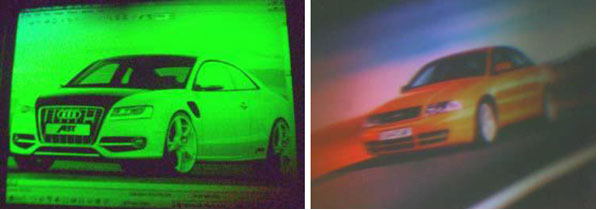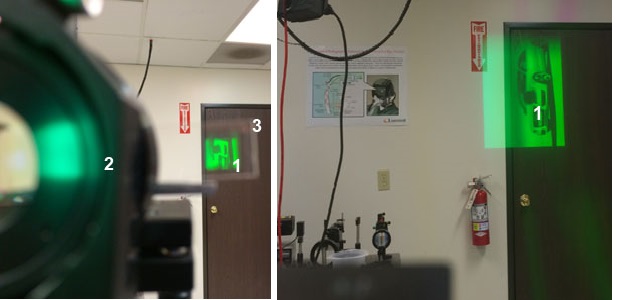Luminit Science at Work in Head Mounted Displays
By Dr. Fedor Dimov, Technical Fellow, Luminit LLC
Augmented Reality Displays are gaining momentum as more companies recognize the emerging potential of the wearable market. Also referred to as Near to Eye or Near Eye Displays (NEDs), these wearable devices are typically lenses combined with semitransparent beam combiners that create a virtual image in front of the user's field of vision. These displays can be transparent with a virtual image that appears on top of a real world view, such as those used in the Google Glass, or opaque displays often seen in gaming and entertainment.
Luminit scientists have been on the forefront of Holographic Optical Elements (HOEs) for NEDs and Head Mounted Displays (HMDs) for years [See Ref. 1]. Even at its early stages, our technology could rival Google Glass in terms of see through transmission, field-of-view and virtual image position. In Luminit’s HMD the virtual image position can be controlled and placed either in the direct view, shifted to the side, or down or up as in Google Glass. Today, Luminit’s experienced research scientists and engineers are considered field experts in the use of holograms for NEDs and currently tailor products to fit customers’ needs, whether a monochrome or full color system is needed, as seen in Figure 1.

Figure 1: Virtual green and full color images can be seen with Luminit’s SGWH-based see-through HMD.
With this technology, the viewer will see a virtual image that appears to be coming from a distance of infinity. Part of the optical setup responsible for creating these virtual images is a holographic lens, a piece of photopolymer that exhibits the same properties as a conventional lens. One of the biggest challenges facing the use of commercial holography in consumer NEDs is that, by nature, the holographic lens will distort the image. However, Luminit scientists have implemented procedures to minimize the distortion by prerecording the inverse of the predicted distortion. In other words, the two distortions cancel out, leaving crisp, clean images to the eye.
Another example of a way to eliminate the distortion in substrate guided wave-based holographic (SGHW) HMD is to replace the SGWH lens with additional regular refractive lens combined with the SGWH grating laminated to the transparent substrate. The second grating is laminated to the same substrate at some distance with respect to the first grating, and the gratings will couple light in and out of the waveguide. With the correct placement of the microdisplay in the front focal plane of the lens, the image is seen by looking through the second grating that is transparent. As seen in Figure 2, the virtual image can be easily retrieved with no loss of light from the real world.

(a) (b)
Figure 2. a – partial view of the retrieved virtual image 1 from the distance far from the eye box. Lens mount 2 and acrylic substrate 3 are blurred, because the camera is focused to the virtual image located far away. b – full view of the same virtual image 1 from the eye box superimposed on the see through scenario of the lab.
Luminit HOE technology and our experience in holography will no doubt have a positive impact on commercial and non-commercial augmented reality systems so stay tuned on what’s to come.
References:
1. F. Dimov, Phase II Final Report “Viewbox Enhanced Wave-Guided Helmet Mounted Display (VIEW-HMD)”, Army Contract # W15P7T06CL403, 2008
For more information, contact: fdimov@luminitco.com
